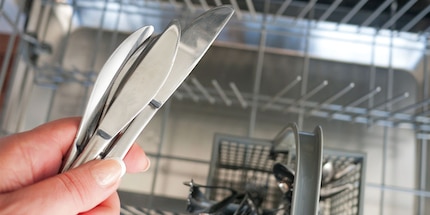

How to get rid of rust film in the dishwasher
The dishwasher is a godsend for every household. However, cutlery and crockery don't always come out of the machine clean. Read on to find out how to prevent rusty knives, forks and spoons.
I know how tedious it is to have to wash the dishes by hand. It's fine for one plate, a few knives and forks, but as soon as two or more people are sharing a household, it gets annoying. Nowadays, having a dishwasher is almost taken for granted. However, sometimes the kitchen utensils that have just been cleaned don't shine like new even after the cleaning process. Red-brown rust has formed, especially on the knife tips.
Problem: flash rust
Washing the whole thing again by hand is tedious and unnecessary. If you think you need to replace the dishwasher, then this may well be an option. However, so-called flash rust can also form in new appliances - because in most cases, the rusty stains do not come from the machine, but from the crockery or cutlery itself. The rust not only looks unclean, but can also attack and destroy the cutlery.

Even small traces of rust on the knife can be a sign of flash rust.
But where does it come from? It's often your own fault: products that are not dishwasher-safe and non-stainless screws and rivets on saucepans, lids or similar items cause rust film to form. In rare cases, the rust can also come from the dishwasher itself. If the plastic coating of the cutlery basket begins to crumble and the metal underneath starts to rust, this rust will spread to your crockery. Then it's high time for a new crockery basket.
Solution #1: Wash with aluminium foil
Tear a roughly square piece off the sheet, crumple it up and place it - together with the cutlery - in the cutlery drawer or compartment. It does not prevent rust from forming, but it does prevent it from depositing on knives, forks and spoons. This is because aluminium foil is less noble and easier to oxidise than cutlery and therefore magically attracts rust.
Solution #2: Find the culprit
Look at everything you had in the machine. Check whether there are any screws, rivets or other parts that are not dishwasher-safe. Sometimes they are not visible at first glance and are hidden under a plastic handle, for example. If you can't find the culprit despite a closer look, you can still use the exclusion method. Wash the utensils you suspect separately (together with cutlery) until you can clearly tell which part is the culprit.

This is how the cutlery should look after cleaning in the dishwasher
Would you like to receive more valuable household tips? Then follow me by clicking on the button at my author profile.
When I'm not stuffing my face with sweets, you'll catch me running around in the gym hall. I’m a passionate floorball player and coach. On rainy days, I tinker with my homebuilt PCs, robots or other gadgets. Music is always my trusted companion. I also enjoy tackling hilly terrain on my road bike and criss-crossing the country on my cross-country skis.
Practical solutions for everyday problems with technology, household hacks and much more.
Show all
